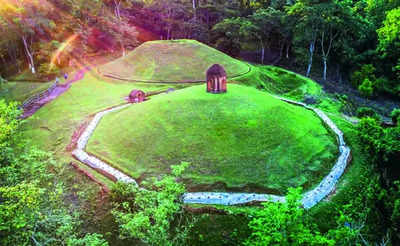Moidams – the Mound-Burial System of the Ahom Dynasty
Set in the foothills of the Patkai Ranges in eastern Assam, the property contains the royal necropolis of the Tai-Ahom. For 600 years, the Tai-Ahom created moidams (burial mounds) accentuating the natural topography of hills, forests and water, thus forming a sacred geography. Banyan trees and the trees used for coffins and bark manuscripts were planted and water bodies created. Ninety moidams – hollow vaults built of brick, stone or earth – of different sizes are found within the site. They contain the remains of kings and other royals together with grave goods such as food, horses and elephants, and sometimes queens and servants. The Tai-Ahom rituals of “Me-Dam-Me-Phi” and “Tarpan” are practiced at the Charaideo necropolis. While moidams are found in other areas within the Brahmaputra Valley, those found at the property are regarded as exceptional.
Moidams – the Mound-Burial System of the Ahom Dynasty are a royal mound burial necropolis established by the Tai-Ahom in northeastern India. Set in the foothills of the Patkai Ranges in eastern Assam, the property contains features sacred to the Tai-Ahom and demonstrates their funerary traditions. Led by Prince Siu-kha-pha, the Tai-Ahom migrated to present-day Assam in the 13th century and selected Charaideo as their first capital and location for the royal necropolis. For 600 years (from the 13th to the 19th centuries CE), the Tai-Ahom created moidams (“home-for-spirit”) that work with the natural features of hills, forests, and water, creating a sacred geography by accentuating the natural topography. Sacred trees were planted and water bodies were created.
Ninety moidams are found within the Charaideo necropolis, sited on elevated land. The moidams have been created by building an earth mound (Ga-Moidam) over a hollow vault constructed of brick, stone or earth (Tak), and topped by a shrine (Chou Cha Li) at the centre of an octagonal wall (Garh). This shape symbolises the Tai universe. The shrine at the top is the Mungklang, a middle space symbolised as a golden ladder establishing a heaven-earth continuum. The vaults contain the buried or cremated remains of kings and other royal individuals together with grave goods such as food, horses, and elephants, and sometimes queens and servants. The moidams within the property testify to the changes in materials and design of the burial mounds over time. This is a physical space where Tai-Ahom royals became gods, symbolising a heaven-earth continuum. The Tai-Ahom rituals of Me-Dam Me-Phi (ancestor worship) and Tarpan (libation) are practiced at the Charaideo necropolis.
